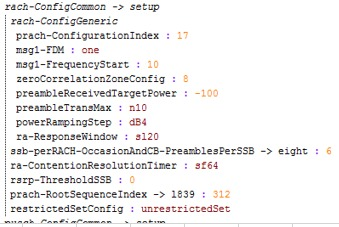Yes, even make it 4 degrees tilt, unless there are mountains and valleys.
Noted.
After tilts.
Are there any other features or parameters that deal with this?
M puzzles as to how 2nd carrier in the same antenna has no issues with interference?
What’s the tilt of 2nd carrier?
Everything is the same Antenna, ports and tilt.
It’s TDD 1st and 2nd carrier.
Do you have full coverage for 1st and 2nd carrier with neighbours?
Or 1st carrier is like end of coverage?
Hi @RFSpecialist, do you have maybe some paperwork or empirical analysis for this?
It is all about km ranges of cell.
We have to align zerocorrelationzone distance, with max delay distance on cell, with preamble format max distance with actual footprint coverage of the cell.
Most networks run with preamble format 0 which is limited to 14 km.
I use the same.
But looking at zero correlationzone we can see even values like 3 which limit the cell proper operation to maximum 1.47 km.
So all 4 km ranges need to be aligned: zerocorrelationzoneconfig, cellradius, preamble format, max delay and cell footprint.
Just look at the RACH success rate in your network and is not even at 50% success rate.
But all those alignments of 4 ranges of kms require lot of work including a new rootsequenceindex plan.
I’m looking one Network and rach sr is bad.
Preamble format is 0 and zero config is 12 but real coverage is 5 km.
From 5G NR in Bullets:
“The Random Access procedure will fail if coverage extends beyond the cell range associated with the cyclic shift”.
You cannot be sure is 5km for all cells.
Maybe some cells reach 10 km others maybe 15 km.
Yes, I will check TA distribution.
zerocorrelationzone 12 gives a rsi reuse pattern of 83.
Which is quite tight to match in urban and residential area.
You should check those counters for 4G.
Also don’t forget that RACH coming from a distance larger than cellradius are not counted by those counters.
Are simply discarded.
To get all samples from all indexes make cellradius 20 km and then you will see how many you actually get.
There are good networks that run with preamble format 1:

So if RACH comes from a distance larger than preamble format distance (which is 14 km for preamble 0) then 6 PRBs of PUSCH will be strongly interfered by PRACH.
Check Figure 248 and table 168 from book: 5G NR in Bullets.
What is current zczc and preamble format, FR range in issue going on above?
![]() so must be FR1.
so must be FR1.
Because FR2 does not support long preambles, right?
1.check Uplink PRB utilization with average number of users for first and second carrier
2.check L.UL.Interference.Avg.PRB0 to L.UL.Interference.Avg.PRB99 (which PRB with high interference)
3.check P0NominalPUSCH for both carriers
Yes, right.
Brainstorming is how to approach this low RACH SR issue given the params above.
We need to check why RACH SR is poor.
- Check RACH attempts TA(Counter provided by Dan)
- Average numbers of Preamble transmitted. There must be some counters which shows hom many RA attempts are done.
If RACH att distance is not beyond permitted range, and Number of RACH attempts per RACH SR are higher, then there is issue of intereference.
There is another issue mentioned above of high PUSCH interference.
But in graphs shows max -120 dBm so I don’t see an issue for it.
This is the graph of pusch interference. It is average, for all PRBs:
Issue is that I think rach from a distance larger than cellradius are not even taken into account in counters.
So first approach would be to increase cell radius for cells with rach success rate less than 30% (say 30%) from 2-3 km to 15-20 km.